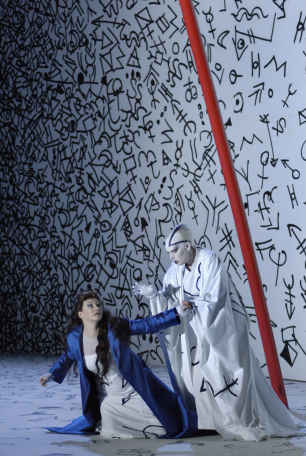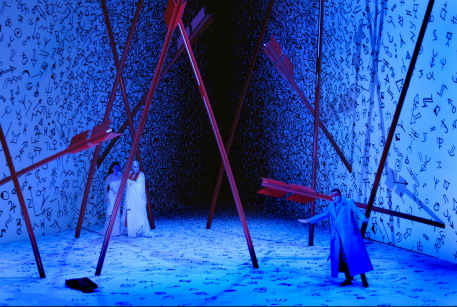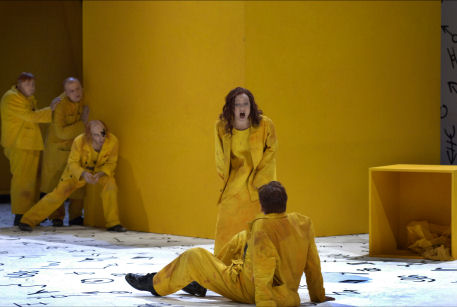Other Links
Editorial Board
- Editor - Bill Kenny
- London Editor-Melanie Eskenazi
- Founder - Len Mullenger
Google Site Search
SEEN
AND HEARD INTERNATIONAL OPERA REVIEW
Richard Strauss: Die Frau ohne Schatten:
(Revival Premiere) Soloists,
Netherlands
Philharmonic Orchestra, Conductor: Marc Albrecht, De Nederlandse
Opera, Amsterdam, 1. 9.2008 (PK)
A Second Life for a wonderful Frau ohne Schatten
Although much of Hofmannsthal's text will always be mysterious even
with surtitles, Homoki succeeds in creating an amazing amount of
clarity, concentrating on the main characters and their psychic
development. His central element is the Empress, sung with great
warmth by Gabriele Fontana, who in the course of three long acts
evolves from frailty and selfishness into a person capable of
compassion and love for humanity. Her counterpoint is the Nurse,
sung with chilling authority by Doris Soffel, who loses more of her
grip on the situation as her pupil the Empress, develops more
character. But the most impressive interpretation came from Evelyn
Herlitzius as the Dyer's Wife. Seemingly effortless, her dramatic
soprano rose over the greatest orchestral climaxes,
while at the same time she managed to give
a most convincing portrayal of a simple woman, lonely and frustrated
by turns, until the moment
where she realises that when luck presents
itself, all you have to do is to grasp it.
On the male side, the veteran Terje Stensvold was a moving and
surprisingly youthful Barak, supported by Torsten Hofmann, Roger
Smeets and Alexander Vassiliev with fine performances as his three
brothers. The radiant tenor of Klaus Florian Vogt sounded very well
in the taxing part of the Emperor, although he could not
completely avoid the impression that his
lyrical voice had reached its limits with
this part. The Netherlands Opera was less
lucky with the singers for some of the smaller parts, but within the
scale of the whole production these were details of minor
importance: especially so because for the greater part of this very
long evening, most of the attention went
to the really astonishing playing by the Netherlands Philharmonic
Orchestra. They produced overwhelming tutti and really
brilliant solo parts, especially in a breathtaking opening of the
great scene of the Emperor by the first violoncello. Responsible for
all this was Marc Albrecht, making an impressive debut in Amsterdam.
His colourful handling of the climactic moments demonstrated all of
his talents as a musical authority, but there was real magic too
whenever the score called for some hints of chamber music. Die
Frau ohne Schatten will always be a difficult opera and the
third act with its choruses of 'unborn children' is certainly not
the most inspired product of the cooperation between Strauss and
Hofmannsthal. But with a conductor like Marc Albrecht one can
cherish every minute of a very long evening.
Cast:
Gabriele Fontana (Die Kaiserin)
Klaus Florian Vogt (Der Kaiser)
Doris Soffel (Die Amme)
Peter Eglitis (Der Geisterbote)
Terje Stensvold (Barak)
Evelyn Herlitzius, (Sein Weib)
Roger Smeets (Der Einäugige)
Alexander Vassiliev (Der Bucklige)
Torsten Hofmann (Der Einarmige)
Lenneke Ruiten (Die Stimme des Falken & Der Hüter der Schwelle)
Corinne Romijn (Eine Stimme von Oben)
Production:
Director: Andreas Homoki
Sets and costumes: Wolfgang Gussmann.

At a time when most of the trendy presentations in opera
theatres enjoy a relatively short life,
some productions seem to last forever: and
even seem to get better at every revival. One of these
is this Die Frau ohne Schatten designed originally for the
Opera in Geneva in 1991, where it had a glorious
debut conducted by the late Horst Stein. Even more
enthusiastic was the reception at the Théâtre Châtelet in Paris
two years later, with Christoph von Dohnányi
conducting. Perhaps the greatest triumph however awaited producer
Andreas Homoki and designer Wolfgang Gussmann, when they revived the
production fifteen years later for The Netherlands Opera.
The greatest strength of this performance is the way Homiki and
Gussmann reduced this gigantic opera, full of symbols and hidden
meanings, into one single, almost empty staging,
using only five different colours for the sets. White with black
hieroglyphs represents the realm of Keikobad and his ghosts, where
everything is clear and transparent, and where shadows do not exist.
Here the opening scène, when the Nurse almost literally emerges out
of the set, is a real lucky strike and is unforgettable at the same
time. The primal colours blue and red represent the world of the
Emperor, with the Empress changing from white into blue in a most
ingenious manner when she surrenders herself to the world of the
human beings, while red is used for gigantic arrows (the feathers of
the 'red falcon'?), gradually threatening to suffocate the Emperor.
Yellow is reserved for Barak and the 'common people', as a symbol of
earth, mud and craftsmanship. Apart from the red arrows,
the set consists only of two gigantic black and white walls ending
in a black space - which may be 'nothing'
as well as 'eternity' - some yellow boxes
and a gigantic ball as a symbol of Keikobad’s powers.


Pictures
Clärchen und Matthias Baus
Back
to Top
Cumulative Index Page
